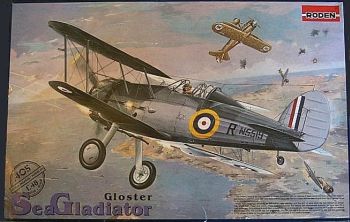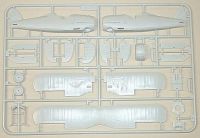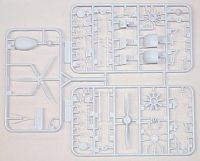Roden 1/48 Sea Gladiator |  | History I'll delve into the history of the Sea Gladiator when I build this kit for a future issue of Internet Modeler. The Kit The only injected kit of the Gladiator I know of in 1/48 scale is the old Pyro/Life Like/Lindberg one, and although a nice kit even by today's standards, it is around forty years old. But now Roden has recently released new kits of both the Gladiator and it's nautical brother, the Sea Gladiator.  The kit comes on three sprues. One for the clear parts, and two others molded from light gray plastic for the aircraft. The decal sheet has markings for eight different Sea Gladiators. I was surprised to see this many options. Usually you have just two or three to choose from in a typical model kit. The instruction sheet is well done, but is vague on part placement in a few of the steps. The kit comes on three sprues. One for the clear parts, and two others molded from light gray plastic for the aircraft. The decal sheet has markings for eight different Sea Gladiators. I was surprised to see this many options. Usually you have just two or three to choose from in a typical model kit. The instruction sheet is well done, but is vague on part placement in a few of the steps.
I measured the span of the top wing, and it came out exactly 32 feet and three inches, as per the prototype. I placed the parts on a 1/48 scale print I have of the Gladiator. The kit's outlines matched up to the print almost exactly. I couldn't find any complaints with the scale accuracy or the outline at all. With the exception of the wing flaps, all control surfaces are molded separately. The flaps are scribed using raised detail on both the upper and lower wings. The cockpit entrance hatches are also molded separately, as is the three piece cowling.  The fuselage has been molded with a very faint roughness, which may be to provide some fabric detail. Unfortunately, it also covers the metal parts of the forward fuselage. The wings have no fabric detail, and are molded smooth. Rib detail is very subtle, with none of the "starved cow" appearance seen on many biplane kits. The fuselage has been molded with a very faint roughness, which may be to provide some fabric detail. Unfortunately, it also covers the metal parts of the forward fuselage. The wings have no fabric detail, and are molded smooth. Rib detail is very subtle, with none of the "starved cow" appearance seen on many biplane kits.
Cockpit detail is Spartan, but adequate. An instrument panel (with decal gauges), throttle, seat, rudder pedals, compass, floorboards, and a very nicely done control stick are provided. The Bristol Mercury engine is a very reasonable replica, although the plumbing for it is molded a bit on the heavy side Sea Gladiators differed from the land based version by having catapult hardpoints, an arrestor hook, and a dingy stowage compartment under the fuselage. The latter two parts are provided, as is the three bladed prop, which was also used on this aircraft. Disappointments  The first thing that hit me was the decal sheet. The colors are too bright, with the red and yellow being almost "neon" shades. They are also very thin and brittle-several of the individual markings had "holes" where pieces had flaked off from the sheet, rendering several of them useless. The first thing that hit me was the decal sheet. The colors are too bright, with the red and yellow being almost "neon" shades. They are also very thin and brittle-several of the individual markings had "holes" where pieces had flaked off from the sheet, rendering several of them useless.
Not all the locating holes for the rigging are molded in. Many of the ones that are appear to be done by drilling holes in the mold itself, so there are tiny "pins" that need to be cut off, then drilled out for the rigging to be attached. The clear parts are on the heavy side, which causes them to be somewhat opaque, rather than crystal clear. The sprue that contains the fuselage halves and wings on my kit appears to have been injected at a less than optimum temperature for molding. The wings have "swirl" patterns in them, and have dips and valleys on the surfaces. The outside of the handholds on the top wing did not flow and merge together, but rather there is a very evident gap here. This may be just the case in my sample kit.  There is some heavy cockpit detail on the interior fuselage halves, which creates "troughs" on the exterior sides and oil cooler. This is also evident on the wing surfaces where the ailerons attach. It looks like some careful sanding (and some filling) should remove them. There is some heavy cockpit detail on the interior fuselage halves, which creates "troughs" on the exterior sides and oil cooler. This is also evident on the wing surfaces where the ailerons attach. It looks like some careful sanding (and some filling) should remove them.
Conclusion There are some defects with the kit, but there isn't anything that can't be corrected with a little time and patience. I think Roden should be applauded for supplying an accurately scaled kit of an aircraft that falls outside the main stream of modeling subjects. Overall appeal will probably be limited, but should be good for those of us who find a special place for aircraft that represent the last of the biplane fighter era. Our thanks to Roden for the review kit. | 








|
